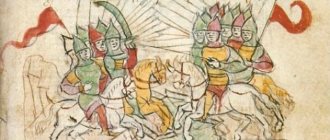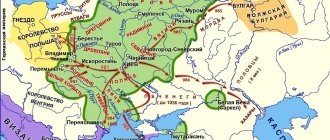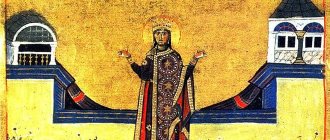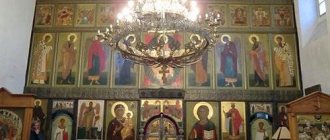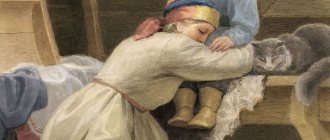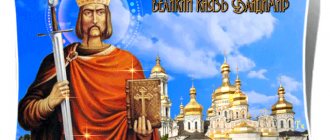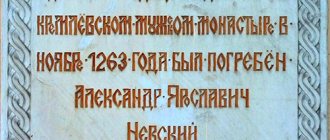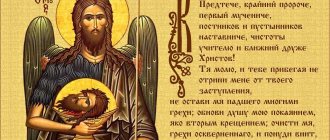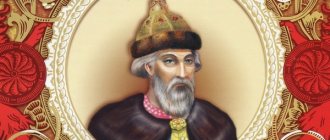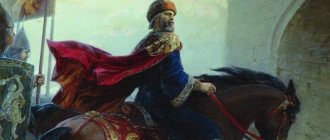The children of the great Vladimir Svyatoslavich are very numerous, which is not surprising - the Grand Duke was very loving both before and after the adoption of Christianity. In total, we can more or less reliably talk about 15 of his children from different wives. Most of them faced a sad fate - after the death of Vladimir the Saint, his sons began to fight each other for the right to primacy in governing the state, as a result of which many were killed.
The battle between the troops of the brothers Yaroslav and Svyatopolk near Lyubech (1016). Radziwill Chronicle.
Children of Vladimir and Rogneda
Izyaslav I Vladimirovich
Izyaslav I Vladimirovich (980/981 - 1001)
More details
The eldest son of Vladimir the Baptist and Rogneda became the founder of the dynasty of princes of Polotsk, where Izyaslav reigned in 989-1001. Only fragmentary information about the prince remains. 100 years after his death, the chronicler, wanting to explain the reason for the enmity between the descendants of Vladimir, who occupied Kyiv, and those who occupied the Principality of Polotsk, cites a legend about Rogneda’s attempt on Vladimir’s life and about her saving from death by her son Izyaslav. Nevertheless, on the advice of the boyars, Vladimir gave Izyaslav and Rogneda the region of the latter’s father (Rogvolod), that is, Polotsk, in which he built the city of Izyaslavl (now Zaslavl) for them. Izyaslav restored the destroyed Polotsk, moving it to a higher and inaccessible place at the mouth of the Polota River, on its left bank. It is likely that at first his mother Rogneda was his regent.
Yaroslav Vladimirovich the Wise
Yaroslav the Wise. Portrait from the Tsar's title book, 1672. (978 - 1054)
Biography of Yaroslav
Section on Yaroslav
Second son of Vladimir the Baptist and Rogneda. According to legend, he witnessed his father’s attempt to execute his mother for attempted murder. Even as a child, he was sent by his father, first to Rostov, and then to Novgorod. Since 1014, relations between father and son have deteriorated. Yaroslav refused to pay the due tribute from Novgorod and began to gather troops for the upcoming war, but Vladimir soon fell ill and died.
After the death of Vladimir, Yaroslav entered into a bloody internecine war with his brother Svyatopolk the Accursed, in which, as a result of four years of confrontation, he was able to gain the upper hand. Then Yaroslav had to face claims to part of his father’s inheritance from another brother, Mstislav of Tmutarakan.
Despite domestic and foreign policy problems, Yaroslav the Wise was not only able to retain power in the state, but also expanded its borders, strengthened protection against raids by nomads, and was also able to raise the authority of the state among other European countries. The period of Yaroslav's reign is considered the heyday of Kievan Rus.
Vsevolod Vladimirovich
(983/984 - until 1013)
In 988, the Kiev prince Vladimir Svyatoslavich conquered a city called Lodomer on the lands of the Volynians and Buzhans on the right bank of the Luga River. The prince named the city after himself and handed it over to one of his sons, Vsevolod, to manage it. So the third eldest son of Rogneda from Vladimir received Volyn as an inheritance with its center in Vladimir.
There are several versions regarding the fate of the prince: D. Likhachev supported Brown’s hypothesis about the identity of Vsevolod with Vissavald, whom Sigrid the Proud burned in the bathhouse; Brown believed that the Varangian entourage incited the boy to break with his father and took him to Sweden (by that time Vsevolod could have been 11-12 years old); Voitovich considers Brown's version unlikely.
Predslava Vladimirovna
(approx. 983 - after 1018)
More details
One of the eldest daughters of Grand Duke Vladimir the Baptist. In the internecine struggle of the Vladimirovich brothers in 1015-1019, she took the side of her brother Yaroslav the Wise. Predslava was an educated girl - she would later be known for her letters. Predslava lived and grew up with her mother and then her sisters in the village of Predslavin, which was named after her.
In 1015, Grand Duke Vladimir Svyatoslavich died, which marked the beginning of a power struggle between his sons. Later and a number of foreign sources mention that Boleslav I the Brave, called to the aid of Svyatopolk to capture Kyiv in 1018, made Predslava his concubine and took him by force to Poland. After this, her name is not mentioned in the chronicles.
Premislava Vladimirovna
(unknown - 1015)
Almost no information has been preserved. There is indirect evidence according to which this daughter of Vladimir and Rogneda in 1000 married Laszlo the Bald, Duke of Hungary, who owned the lands between the Maros and Gran rivers.
Mstislava Vladimirovna
(978/987 - unknown)
Mstislava is mentioned among the three daughters of Vladimir, taken as concubines by King Boleslav I the Brave of Poland in 1018. According to the assumption of the Polish historian Lyabuda, in Poland the captured daughters of Vladimir the Saint (along with Predslava, several of her sisters were captured) lived in a palace on Lednice Island, and they were not forced to convert to Catholicism.
Around 1025, when Bolesław died, the captives were freed. After this, Mstislav is not mentioned anywhere. She had no family.
Feuds between brothers
When the sons grew up, Svyatoslav, who had previously been more interested in military campaigns than in affairs in the lands under his control, distributed them to his sons. As a result, Yaropolk received Kyiv, Oleg received the land of the Drevlyans, and Vladimir Svyatoslavich was sent as governor to Novgorod.
After the death of his father in 972 in a battle with the Pechenegs, his heirs became full rulers in their principalities. However, peaceful life soon came to an end.
For a minor reason, Oleg killed Yaropolk's comrade-in-arms. He flew into a rage and, at the instigation of the Varangian governor Sveneld - the father of the stabbed warrior - decided to take away the Drevlyan lands from his brother. A battle took place in which Oleg was crushed to death by his own retreating warriors. Having become the ruler of not only Kyiv, but also the Drevlyan lands, Yaropolk decided to remove Vladimir from the road, especially since he always considered him the son of a slave and placed him below himself.
From a Greek nun, widow of Yaropolk
Svyatopolk the Accursed
Svyatopolk the Accursed (c.979-1019)
More details
According to the Tale of Bygone Years, he was born to the widow of Yaropolk Svyatoslavich, a Greek nun captured by Svyatoslav and, after the murder of Yaropolk, taken by Prince Vladimir as a concubine. Vladimir himself recognized Svyatopolk as his son, but indirect evidence (the origin of the name and the further confrontation between Svyatopolk and his brothers) leaves room for a theory about Yaropolk’s paternity. Svyatopolk was married to the daughter of the Polish prince Boleslav the Brave. In the last years of Prince Vladimir’s life, having learned that he wanted to bequeath power to his beloved son Boris, Svyatopolk tried to organize a conspiracy, but was discovered and, together with his wife, was imprisoned. After the death of Vladimir in 1015, Svyatopolk was freed by his supporters and took the Kiev throne. From this moment, a bloody civil strife began, during which three half-brothers of Svyatopolk were killed (according to official history - on the orders of Svyatopolk) - Boris, the Murom prince Gleb and the Drevlyan Svyatoslav.
Children from the Bulgarian Princess Miloliki
Boris Vladimirovich
Boris Vladimirovich - fragment of an icon (ca. 986 - 1015)
More details
According to the initial Kyiv Chronicle, he was born of a Bulgarian mother and during the second division of lands he received Rostov as an inheritance. In 1015, Prince Vladimir fell ill, and Boris was called to Kyiv. Soon after his arrival, it became known about the Pecheneg invasion, and his father sent him with a squad to repel the raid. Boris did not meet the Pechenegs anywhere and, returning back, stopped on the Alta River. Here he learned about the death of his father and about the occupation of the grand-ducal table by his half-brother Svyatopolk. The squad offered to go to Kyiv and seize the throne, but Boris rejected this offer, as a result of which his father’s squad left him and he remained with his closest people. According to official history, Svyatopolk sent Putsha and the Vyshgorod boyars to kill his brother. Boris's body was secretly brought to Vyshgorod and buried there in the church of St. Vasily. Boris was about 25 years old. Later, he and his brother Gleb were canonized.
Gleb Vladimirovich
Gleb Vladimirovich - fragment of an icon (ca. 987 - 1015)
More details
Baptized David, Prince of Murom (circa 1013-1015). According to the official historical theory, after the murder of Boris, Svyatopolk, fearing revenge, decided to kill Gleb as well. Chronicles report that Gleb, having heard about the death of his father, hurried to Kyiv. Down from Smolensk he sailed along the Dnieper in a boat. He had a small squad with him. At Smyadyn, an ambassador from Yaroslav the Wise from Novgorod caught up with him and conveyed the message: “Do not sail further. Your brother Boris was killed by Svyatopolk.”
Hearing this, Gleb began to cry and pray, and in the meantime the killers sent by Svyatopolk arrived, whom he sent to intercept Gleb on the road. Having quietly crept up to the prince's ship, the killers captured it and disarmed all his servants. One of the murderers, named Goryaser, forced the cook Gleb, named Torchin, to kill the prince.
In 1019, when Yaroslav occupied Kyiv, on his order, Gleb’s body was found, brought to Vyshgorod and buried along with the body of Boris at the Church of St. Basil.
From Adelya
Mstislav Vladimirovich
Mstislav Vladimirovich the Brave (c.983-1036)
More details
Around 990/1010 Mstislav was appointed by Vladimir to the Tmutarakan principality. In 1023, while Yaroslav was pacifying the rebellion in Suzdal, Mstislav approached Kyiv, however, he did not besiege the capital and occupied Chernigov. In 1024, near Listven in the Chernigov region, a battle between Mstislav and Yaroslav took place, in which Yaroslav was defeated and fled to Novgorod. In 1026, the brothers made peace in Gorodets, according to which Yaroslav received Kyiv and the right side of the Dnieper, while Mstislav retained the left side with Chernigov and Pereyaslavl.
Subsequently, the brothers made a joint campaign against Poland in 1031, returning the Cherven cities, lost during the internecine war of 1015-1019, to the rule of Kyiv.
Until Mstislav's death while hunting in 1036, Yaroslav preferred to rule from Novgorod.
Stanislav Vladimirovich
(984/987 - before 1015)
Son of Vladimir Svyatoslavich and, presumably, Adelya. According to the later Nikon Chronicle, around 988 Stanislav received Smolensk as an inheritance. Stanislav intervened little in the life of the city, he could not or did not want to fight the Varangians, only twice a year he went to the Krivichi for tribute and sent it to Kyiv.
Obviously, Stanislav died before his father, leaving no offspring. It is worth noting that Stanislav is the only known bearer of this name among the Rurikovichs in the pre-Mongol period.
Sudislav Vladimirovich
(984 — 1063)
More details
Son of Vladimir Svyatoslavich and, presumably, Adelya. Nestor mentions it for the first time in 988. According to the Nikon Chronicle, when the struggle between Yaroslav and his father began, Vladimir separated Pskov from the Novgorod principality and gave it to Sudislav. There is no information about Sudislav’s participation in the Vladimirovich strife of 1015-1019. In 1036, after the death of Mstislav, Yaroslav apparently decided to protect himself from further claims to the Kiev throne and captured Sudislav, putting his brother in prison and liquidating the Pskov principality.
He spent about 23 years in captivity and was released after the death of Yaroslav - in 1059, the “Yaroslavich Triumvirates” took an oath from his uncle and released Sudislav. After his release, he became a monk at the Kiev Monastery of St. George, where he died in 1063.
Other children of Prince Vladimir
Son of Vladimir and the “Czech woman” Vysheslav Vladimirovich
(c. 977 - after 1010)
Prince of Novgorod, the eldest of the sons of Vladimir, from the “Czech” (according to the “Saga of Olaf son of Tryggvi” - Allology, according to Tatishchev - the Varangian Olova, “Norwegian princess Olava”). In 988 (989) he received the Novgorod reign from his father, in which he died, according to Tatishchev - in 1010, and according to Miller - in 1012. His brother, Yaroslav, was transferred to Novgorod from Rostov in his place.
Svyatoslav Vladimirovich Prince Drevlyansky
(c. 982—1015)
More details
Around 990, Svyatoslav received the Drevlyansky principality. In 1015, having learned about the death of Boris and Gleb, Svyatoslav left his capital and tried to flee to the Carpathians. Svyatopolk and his retinue caught up with the prince on the bank of the Opir and gave the order: “Chop them all.” The legend connects the name of the city Skole with this episode. Prince Svyatoslav died in this battle, and his warriors refused to go into the service of Svyatopolk. The daughter (according to another version, wife) of Svyatoslav, Paraskovia (Parashka) took refuge on the top of the mountain and, overtaken by Svyatopolk’s warriors, threw herself off the cliff. Now the mountain is named in her honor Parashka.
Pozvizd Vladimirovich
(before 988 - unknown)
Son of Vladimir Svyatoslavich, mentioned only in the chronicle list. No information about him has been preserved. Some researchers considered him not the son, but the nephew of Vladimir. It is unknown who exactly his mother was, and whether he owned any inheritance in Rus'. According to the Gustino Chronicle, he had possession in Volyn. Time of death is unknown.
Family
The father of Prince Vladimir was the famous commander and at that time the ruler of Kyiv Svyatoslav Igorevich. The latter was the only son of Igor Rurikovich and Princess Olga, who was the first among Russian rulers to convert to Christianity.
Vladimir's mother, Malusha, was the housekeeper and alms distributor for Princess Olga. She yielded to the claims of Svyatoslav, who was married to the Ugric princess Predslava and had two sons from her - Yaropolk and Oleg.
Olga, angry at Malusha, who conceived a son in sin, sent her to the village of Budyatino. When the boy was 3-4 years old, he, already without his mother, was returned to Kyiv. There he was under the supervision of his grandmother Olga, since pagan laws accepted him as a princely heir. In addition, Vladimir was looked after by his maternal uncle Dobrynya, who was the Kyiv governor.
In search of a new unifying ideology
The pantheon of gods among the various tribes inhabiting Vladimir's domain was quite diverse, so paganism prevented the formation of a powerful unitary state. Being a far-sighted politician, the prince understood that the country needed a more advanced religion. Then Christianity attracted his attention, especially since its adherents were increasing every day, including among nobles. Suffice it to say that Vladimir Svyatoslavich’s own grandmother professed this religion. During his childhood years spent at the court of Princess Olga, he probably had the opportunity to observe how Kyiv Christians carried out their rituals. In addition, the prince most likely could have had some idea about the salvation of the soul and resurrection after the Day of Judgment.
The political aspect of choosing Christianity as the state religion was also important for Vladimir, which promised the strengthening of allied relations with Byzantium.
Power grab
To achieve the final victory over his brother, Vladimir Svyatoslavich resorted to bribery. He managed to win over to his side the governor Blud Iveshchey, who persuaded Prince Yaropolk to leave Kyiv and strengthen himself in the Roden fortress. Soon Vladimir's army arrived there and began a siege. The defenders of the fortress had a hard time. Yaropolk was forced to agree to negotiations. However, his brother prepared a trap for him and killed him in an ambush. In Rodin, Vladimir took a liking to his brother’s pregnant wife, a former Greek nun. Soon after this, the woman gave birth to a son, Svyatopolk, whom the prince raised as his own.
Ascension to the Kyiv throne
Yaropolk's warriors came under the command of Prince Vladimir Svyatoslavich. Thus he formed a fairly large army. Vladimir understood that it was time for him to part with the Varangian mercenaries, since he did not want the plunder of Kyiv. Before heading there, the prince sent the rest to Constantinople, to serve the Byzantine emperor, promising “mountains of gold.” The deal was successful for both parties, since Constantinople needed warriors to protect them from external and internal enemies.
Baptism of Rus'
Returning to Kyiv, Vladimir Svyatoslavich (date of birth - around 960, date of death - July 15, 1015) first ordered his sons to be baptized. Then the prince gathered the inhabitants of the city on the banks of the Dnieper. On his orders, a mass baptism took place, which no one dared to oppose.
To strengthen the new faith, Vladimir ordered the construction of a temple of the Most Holy Theotokos and a tenth of all state income to be given to the church.
To convert residents of other cities to Christianity, the prince called priests and educators from Greece. Special educational institutions were created to train local clergy. In addition, a church charter was published, called the Helmsman's Book, and on Mount Athos Vladimir acquired a monastery for Russian monks. Mass construction of churches began in all corners of the state.
Consolidation of power
In order to give legitimacy to his rule, Vladimir Svyatoslavovich decided to enlist the support of the priests. He liked paganism because it justified polygamy and did not condemn him for having a huge number of concubines.
To appease the idols, the prince built a temple in his capital. Rituals and sacrifices were regularly held there. Vladimir Svyatoslavich ordered the main idol Perun to be given the features of himself.
The people were impressed by the prince's worship of traditional gods, so they treated the new ruler well. In addition, the first 10 years of the reign of Vladimir Svyatoslavich were marked by numerous victories over warlike neighbors, especially in the west, which helped strengthen the borders and allowed the population not to fear raids.
Memory
For his greatest services, Vladimir Svyatoslavich (reign: 978-1015) in the creation of the Russian state was canonized by the Orthodox Church. In addition, he is revered by Catholics, since he lived before the Ecumenical Schism.
Every year on July 15 in Russia and in many other countries the day of his memory is celebrated. In Moscow, Kyiv, Sevastopol, Belgorod, etc. St. Monuments were erected to Vladimir, and a temple was built in his honor on the territory of Chersonesus.
Now you know the biography of Vladimir Svyatoslavich. It is difficult for a modern person to understand many of his actions. However, it cannot be denied that it was he who laid the foundations of Russian statehood and united the nation.
